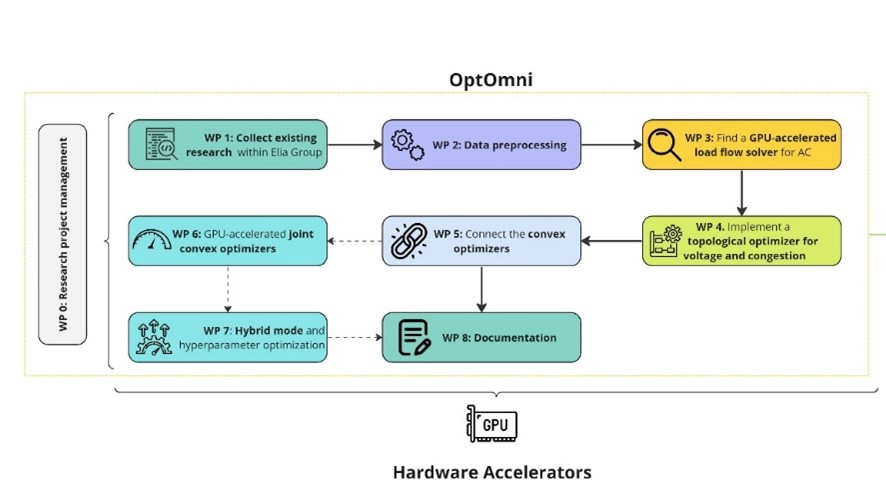19 September 2024
OptOmni: towards a holistic grid optimizer
The project OptOmni aims to join two grid control problems which are currently treated separately: Voltage Control and Congestion Management.
Context
With the latest update of the National Energy and Climate Plan (NECP 2021-2030), Belgium has committed to an overall 47% reduction in greenhouse gas emissions compared to 2005 and an energy mix including 82209 GWh renewable energy. This increase in renewable injection and the growing electrification of our society results in large challenges for the transmission grid.
Moreover, industry’s transition to net zero is accelerating, as demonstrated by Elia Group’s 2022 study ‘Powering Industry Towards Net Zero’. This highlights how industry’s electricity consumption is due to increase by 50% by 2030 in Belgium. Belgium’s total demand (industrial, households and tertiary sectors) for electricity is therefore due to reach 113 TWh in 2030 (up from 82.1 TWh in 2020; a 38% increase).
Therefore, the grid infrastructure is expected to be operating to its limits, decreasing its operational margins while increasing the demands for protection, automation, and control systems.
The project OptOmni aims to join two grid control problems which are currently treated separately: Congestion Management and Voltage Control.
-
Congestion ManagementCongestion Management analyzes the transmitted power of the grid elements and attempts to minimize the overload. Overloads can be reduced by changing the topology or adjusting the active power before and after the bottleneck (redispatch). AC or DC load flow solvers can be used to determine the power, with the former being more accurate. The problem is separated into a convex portion, the redispatch optimization using an optimal power flow, and a non-convex portion, the topology optimization trying to find a topology that minimizes redispatch costs through non-costly grid measures such as switching. Preferably, cheap topological actions are used over costly redispatch actions, and in our prior projects we could demonstrate the viability of a topology optimizer on a full-scale grid.
-
Voltage ControlIn Voltage Control, the occurring voltage of the grid elements is considered, which must lie within a certain range to prevent disconnections. Like congestion optimization, this problem includes convex and non-convex measures. The non-convex portion consists of topology measures, the convex portion includes switching of capacitor banks, shunts and other reactive power controls. Topology measures for Voltage Control are currently under-explored, and OptOmni aims to transfer the results achieved on Congestion Management to the topic of Voltage Control.
The overload energy of an individual grid element is defined as the amount of the transmitted power on the element that exceeds the rated power. Congestion Management is usually interested in the overload in the event of an outage. We therefore define the overload energy of the whole grid as a function of all possible individual outages (N-1 cases). For each individual grid element, we consider the overload in the worst N-1 case and add these up to the total overload energy.
The connection of individual network elements is described in the grid topology. Busbars are the nodes of the network. Lines and transformers form the branches, connecting nodes across different locations or voltage levels. Several busbars in a substation can be connected via busbar couplers. For this project we consider the following topology measures:
a) Switching lines or transformers On or Off
b) Changing the assignments of branches and injections to busbars
c) Separating busbars by opening the busbar coupler
Approach
During this project three different approaches will be evaluated:
-
Separate sequential approach
The most trivial combination of the two problems is by running the individual optimizers separately. This is the current operational practice, but potentially not the best one. A possible order could be
- Topology for Congestion Management
- (limited) Topology for Voltage Control
- Redispatch for Congestion Management
- Linear voltage optimization
Also, different orders could be possible. In this setting, it is possible that the optimizers are competing and actions that were good for Congestion Management would be undone by a later Voltage Control or vice versa. How strong this effect appears and how much of this effect can be avoided by a joint optimization is an open research question and should be answered in this work.
-
Joint Sequential approachFor joint congestion and voltage optimization, the two optimizations need to be joined. Both the convex and the non-convex portions can and should be joined into one optimization problem with a weighted sum of the individual optimization aims. The non-convex optimization evaluates both congestion and voltage problems, while for the convex part the redispatch equations can be joined together with the voltage equations. It could look like:
AC Topology optimization on congestion energy and voltage alignment (non-convex)
Redispatch optimization + Linear voltage optimization (shunts, capacitors, ...) (convex) -
Fully Integrated Approach
Instead of optimizing a heuristic in the non-linear portion of the optimization, directly optimize the true redispatch costs and the true remaining voltage actions. This requires the convex optimal power flow (OPF) and the convex Voltage Optimization to be executed in the search loop of the non-convex optimization, and hence a great effort should be put into performant implementation of these components. As the non-linear optimizations require millions of evaluated samples, likely massively parallel and scaled out optimizers are required (e.g. GPU-based optimizers)
The loop would look like this:
Propose a new set of topologies to evaluate according to the non-linear optimizer.
Evaluate using a full redispatch optimization + Linear voltage optimization.
Jump back to 1, repeat until satisfied.






